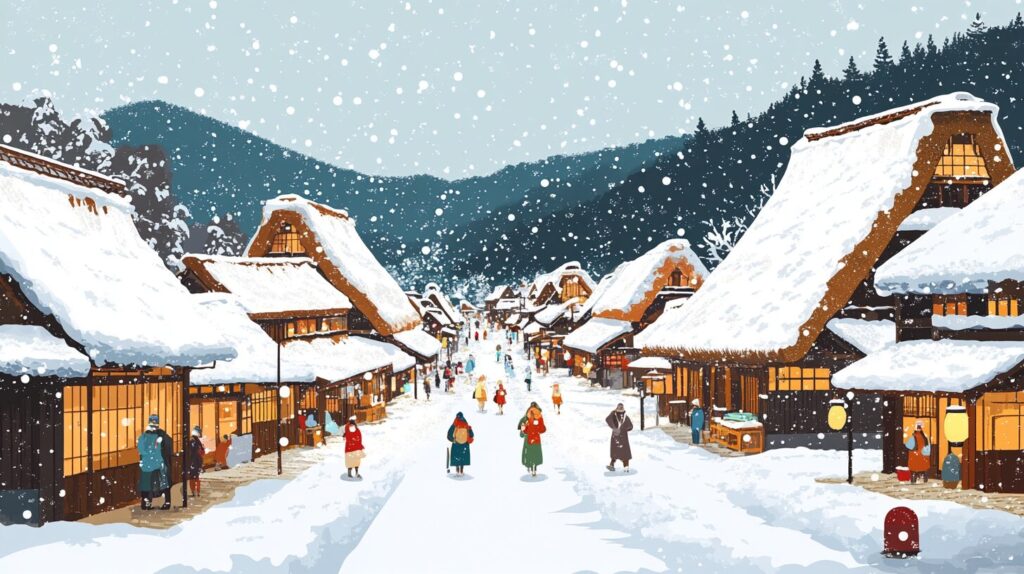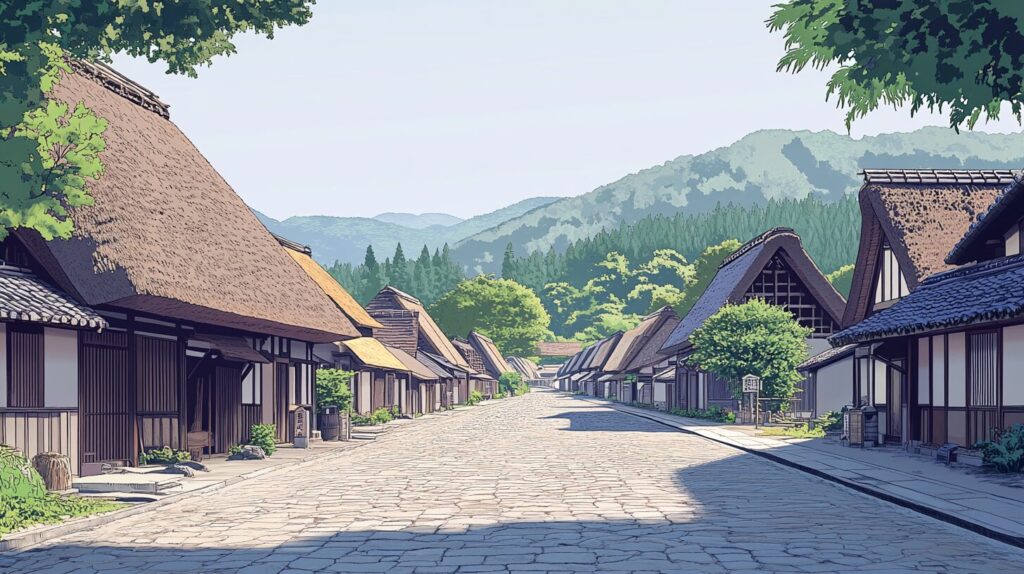大内宿を英語で説明・紹介するための基本情報と、英会話に役立つ表現をシンプルでわかりやすい英語で紹介します。
英会話ダイアローグ・関連情報・10の質問を通して、大内宿に関する英語表現を学びます。
英語
英会話ダイアローグを読む前に知っておくと良い前提知識と情報です。
- 大内宿の歴史的背景
- 江戸時代の重要な宿場町で、交通の要所として旅人に利用されていた
- 茅葺き屋根の民家が約40軒現存、当時の雰囲気をそのまま残している
- 大内宿の特徴
- 茅葺き屋根の家並みや石畳の道があり、江戸時代の雰囲気を楽しめる
- 名物料理「ネギそば」は、箸の代わりに長ネギを使って食べるユニークな体験
- 季節ごとの魅力
- 冬:雪で覆われた茅葺き屋根が幻想的な景色を作り、2月には雪まつりも開催される
- 秋:10月中旬頃には周囲の山々が紅葉し、色鮮やかな景色を楽しむことができる
- 観光スポット
- 町全体を見渡せる展望台があり、茅葺き屋根の家々と自然の景色が一望できる
2人が大内宿について話しています。
大内宿の歴史的な背景、江戸時代の宿場町としての役割、茅葺き屋根の町並み、名物のねぎそば、冬の雪祭りや秋の紅葉などを話題にしています。
会話 / dialogue

Hey Key, have you heard of Ōuchi-juku? I’ve been really interested in visiting recently.

Oh, Ōuchi-juku! Yes, I’ve been there. It’s this really well-preserved Edo-period post town in Fukushima, right?

Exactly! I was reading about it, and it seems like such a fascinating place, with all those thatched-roof houses still intact. It must feel like stepping back in time.

It really does. The main street is lined with traditional houses, and the atmosphere is so authentic. You can walk on the stone-paved streets and imagine what it was like during the Edo period, when travelers stopped there for rest.

That sounds amazing. I heard one of the highlights is the negi soba. They give you a long green onion to eat the noodles with instead of chopsticks?

Yes! It’s such a fun and unique experience. It’s a bit tricky at first, but it’s definitely part of the charm. You should try it when you visit. Many of the restaurants there serve it.

I definitely will! Another thing that caught my attention is the seasonal beauty. I saw some photos of Ōuchi-juku in winter, and the snow-covered roofs look absolutely stunning.

Oh, winter is one of the best times to go! The snow makes the town feel even more magical. Plus, they have the Ōuchi-juku Snow Festival in February, where you can see snow sculptures and other traditional events.

That’s right! I read about the snow festival. It seems like such a great time to visit. But I’ve also heard that autumn is popular too, with the red and yellow leaves in the surrounding mountains.

Yes, mid-October is perfect for the autumn colors. The scenery is breathtaking, with the colorful leaves contrasting against the thatched roofs. You can enjoy the beauty of nature along with the town’s historical charm.

It sounds like there’s no bad time to visit! I’m torn between going in winter for the snow festival or in autumn for the leaves. Which season did you visit?

I went in autumn, and the colors were incredible. But I’ve heard from friends that the winter scenery is just as beautiful, especially if you love snow.

I really do. It must be so peaceful with all that snow. I also read that Ōuchi-juku used to be an important stop for travelers on their way to Edo. It’s fascinating how the town has kept that history alive.

Yes, it was a post town on the Aizu-Nishi Kaidō, so it played a big role in travel during the Edo period. And even today, they’ve done a great job preserving the buildings and atmosphere. It’s become a popular tourist spot, but it hasn’t lost its traditional feel.

That’s exactly what I’m looking forward to. I love places where you can really feel the history, and it seems like Ōuchi-juku has done that well. Is there a viewpoint where you can see the whole town?

Yes! There’s a viewpoint up the hill where you can see the entire village. It’s a short hike, but the view is worth it. You can see the row of thatched houses and the mountains in the background. It’s perfect for photos.

I’ll definitely check that out. I’m really excited to go. I feel like Ōuchi-juku will give me a deeper appreciation of Japan’s history and culture.

It definitely will. It’s a place where you can experience the best of both history and nature. Let me know when you plan your trip—I might join you!

Sounds like a plan! I’ll let you know as soon as I figure out the best time to go.
関連情報 / related information
「大内宿」について、理解を深めるための「英語での関連情報」です。
大内宿

Location and History
Ōuchi-juku is a historic post town located in Fukushima Prefecture, Japan. During the Edo period, it was an important stop along the Aizu-Nishi Kaidō, a trade route that connected Aizu-Wakamatsu to Edo (now Tokyo). The town provided accommodations and food for travelers. Today, it has been preserved as it was in the past, with many of its thatched-roof houses still standing.
Unique Features
Ōuchi-juku is famous for its traditional thatched-roof houses, which give visitors a glimpse into the Edo period. One of its unique features is the local dish called negi soba, where diners use a long green onion instead of chopsticks to eat the noodles. This dish is a must-try for tourists.
Seasonal Beauty
Ōuchi-juku is beautiful in all seasons, but it is especially popular in winter and autumn. In winter, the snow-covered roofs create a magical scene, and the Ōuchi-juku Snow Festival in February is a major attraction. In autumn, the surrounding mountains turn red and yellow with the changing leaves, making it a perfect time to visit for those who enjoy nature.
10の質問 / 10 questions
「大内宿」について、理解を深めるための「英語での10の質問」です。
1: What is Ōuchi-juku?
Ōuchi-juku is a historic post town in Fukushima Prefecture, known for its well-preserved thatched-roof houses from the Edo period. It was once an important stop for travelers along the Aizu-Nishi Kaidō route.
2: Why is Ōuchi-juku famous?
Ōuchi-juku is famous for its traditional Edo-period townscape, especially the thatched-roof houses, as well as its unique local dish, negi soba, where a green onion is used instead of chopsticks.
3: What can visitors experience in Ōuchi-juku?
Visitors can walk along stone-paved streets, enjoy the traditional architecture, try the famous negi soba, and visit a viewpoint that offers a panoramic view of the entire village and its surrounding mountains.
4: What is special about Ōuchi-juku’s architecture?
The thatched-roof houses in Ōuchi-juku have been preserved as they were during the Edo period, offering a rare chance to see traditional Japanese architecture up close.
5: When is the best time to visit Ōuchi-juku?
The best times to visit are in winter, when the town is covered in snow, and in autumn, when the surrounding mountains are vibrant with red and yellow leaves.
6: What is the Ōuchi-juku Snow Festival?
The Ōuchi-juku Snow Festival is held in February, where visitors can see beautiful snow sculptures, enjoy local food, and experience traditional Japanese winter events.
7: What is negi soba?
Negi soba is a unique dish in Ōuchi-juku where diners use a long green onion as chopsticks to eat soba noodles. It’s a fun and tasty experience that’s popular with tourists.
8: How can visitors access Ōuchi-juku?
Visitors can access Ōuchi-juku by taking a train to Yunokami Onsen Station, followed by a 15-minute taxi ride. It’s also accessible by car from Aizu-Wakamatsu or Shirakawa IC.
9: Why is Ōuchi-juku popular with tourists?
Ōuchi-juku is popular because of its historical charm, traditional food, seasonal beauty, and well-preserved architecture, which offer a unique glimpse into Edo-period Japan.
10: Are there any festivals in Ōuchi-juku besides the Snow Festival?
Besides the Snow Festival, Ōuchi-juku hosts events throughout the year, including seasonal celebrations that highlight its rich history and culture.

和訳付
会話 / dialogue

Hey Key, have you heard of Ōuchi-juku? I’ve been really interested in visiting recently.
ねえ、Key、大内宿って聞いたことある?最近すごく興味が湧いてきたんだ。

Oh, Ōuchi-juku! Yes, I’ve been there. It’s this really well-preserved Edo-period post town in Fukushima, right?
おお、大内宿か!行ったことあるよ。福島にある、江戸時代の宿場町がしっかり保存されているところだよね?

Exactly! I was reading about it, and it seems like such a fascinating place, with all those thatched-roof houses still intact. It must feel like stepping back in time.
そうそう!調べてたんだけど、茅葺き屋根の家々がそのまま残っていて、すごく魅力的な場所に見えるよ。まるでタイムスリップしたみたいな感じがしそうだね。

It really does. The main street is lined with traditional houses, and the atmosphere is so authentic. You can walk on the stone-paved streets and imagine what it was like during the Edo period, when travelers stopped there for rest.
本当にその通りだよ。メインストリートには伝統的な家が並んでいて、雰囲気がすごくリアルなんだ。石畳の道を歩きながら、江戸時代の旅人たちがここで休憩していた頃を想像できるよ。

That sounds amazing. I heard one of the highlights is the negi soba. They give you a long green onion to eat the noodles with instead of chopsticks?
すごいね!名物のネギそばが有名って聞いたんだけど、長いネギを箸代わりに使って食べるんだって?

Yes! It’s such a fun and unique experience. It’s a bit tricky at first, but it’s definitely part of the charm. You should try it when you visit. Many of the restaurants there serve it.
そうだよ!すごく面白くてユニークな体験だよ。最初はちょっと難しいけど、それも魅力のひとつだね。行ったらぜひ試してみて。多くのレストランで提供されてるよ。

I definitely will! Another thing that caught my attention is the seasonal beauty. I saw some photos of Ōuchi-juku in winter, and the snow-covered roofs look absolutely stunning.
絶対に試してみるよ!あと、季節ごとの美しさも気になったんだ。冬の大内宿の写真を見たけど、雪で覆われた屋根が本当に美しかったよ。

Oh, winter is one of the best times to go! The snow makes the town feel even more magical. Plus, they have the Ōuchi-juku Snow Festival in February, where you can see snow sculptures and other traditional events.
冬は本当にいい時期だよ!雪が降ると町がさらに幻想的になるんだ。2月には大内宿雪まつりもあるから、雪像や伝統的なイベントも楽しめるよ。

That’s right! I read about the snow festival. It seems like such a great time to visit. But I’ve also heard that autumn is popular too, with the red and yellow leaves in the surrounding mountains.
そうだね!雪まつりのことも読んだんだ。訪れるのにぴったりの時期みたいだね。でも、秋も人気があるって聞いたよ。周りの山々が赤や黄色に染まるんだって。

Yes, mid-October is perfect for the autumn colors. The scenery is breathtaking, with the colorful leaves contrasting against the thatched roofs. You can enjoy the beauty of nature along with the town’s historical charm.
そうだね、10月中旬は紅葉にぴったりの時期だよ。カラフルな紅葉と茅葺き屋根のコントラストが本当に美しくて、自然の美しさと歴史的な町の魅力を一緒に楽しめるよ。

It sounds like there’s no bad time to visit! I’m torn between going in winter for the snow festival or in autumn for the leaves. Which season did you visit?
どの時期に行っても外れがなさそうだね!雪まつりの冬か、紅葉の秋かで迷ってるよ。Keyはどの季節に行ったの?

I went in autumn, and the colors were incredible. But I’ve heard from friends that the winter scenery is just as beautiful, especially if you love snow.
僕は秋に行ったけど、紅葉は本当に素晴らしかったよ。でも、友達から聞いた話では、冬の景色も同じくらい美しいって言ってたよ。特に雪が好きならね。

I really do. It must be so peaceful with all that snow. I also read that Ōuchi-juku used to be an important stop for travelers on their way to Edo. It’s fascinating how the town has kept that history alive.
僕、雪が大好きなんだ。雪に包まれた静けさがすごく素敵だろうね。それに、大内宿が昔は江戸に向かう旅人にとって重要な宿場だったって読んだんだ。歴史を今でも保っているのが面白いよね。

Yes, it was a post town on the Aizu-Nishi Kaidō, so it played a big role in travel during the Edo period. And even today, they’ve done a great job preserving the buildings and atmosphere. It’s become a popular tourist spot, but it hasn’t lost its traditional feel.
そうだね、会津西街道沿いの宿場町だったから、江戸時代には旅において大きな役割を果たしていたんだよ。そして今でも、建物や雰囲気がしっかりと保存されているんだ。観光地としても人気があるけど、伝統的な感じは失ってないよ。

That’s exactly what I’m looking forward to. I love places where you can really feel the history, and it seems like Ōuchi-juku has done that well. Is there a viewpoint where you can see the whole town?
それこそ僕が楽しみにしてることだよ。歴史をしっかり感じられる場所が好きなんだよね。大内宿はそれをしっかりと実現してるみたいだね。町全体が見渡せる展望台とかあるの?

Yes! There’s a viewpoint up the hill where you can see the entire village. It’s a short hike, but the view is worth it. You can see the row of thatched houses and the mountains in the background. It’s perfect for photos.
あるよ!丘の上に展望台があって、村全体を見渡せるんだ。ちょっとしたハイキングだけど、その景色は本当に価値があるよ。茅葺き屋根の家々と、その背後に広がる山々が見えるんだ。写真にぴったりだよ。

I’ll definitely check that out. I’m really excited to go. I feel like Ōuchi-juku will give me a deeper appreciation of Japan’s history and culture.
それは絶対に行ってみるよ。今から本当に楽しみだな。大内宿は日本の歴史や文化への理解を深めてくれそうだよ。

It definitely will. It’s a place where you can experience the best of both history and nature. Let me know when you plan your trip—I might join you!
間違いなくそうだよ。歴史と自然の両方を体験できる場所だからね。旅行を計画したら教えてね、僕も一緒に行くかもしれない!

Sounds like a plan! I’ll let you know as soon as I figure out the best time to go.
それはいいね!行く時期を決めたらすぐに知らせるよ。
関連情報 / related information
大内宿

Location and History
Ōuchi-juku is a historic post town located in Fukushima Prefecture, Japan. During the Edo period, it was an important stop along the Aizu-Nishi Kaidō, a trade route that connected Aizu-Wakamatsu to Edo (now Tokyo). The town provided accommodations and food for travelers. Today, it has been preserved as it was in the past, with many of its thatched-roof houses still standing.
大内宿は、福島県にある歴史的な宿場町です。江戸時代には、会津若松と江戸を結ぶ会津西街道の重要な中継地点でした。町は旅人に宿泊や食事を提供していました。現在でも、当時の姿をそのまま保存しており、多くの茅葺き屋根の家々が残っています。
Unique Features
Ōuchi-juku is famous for its traditional thatched-roof houses, which give visitors a glimpse into the Edo period. One of its unique features is the local dish called negi soba, where diners use a long green onion instead of chopsticks to eat the noodles. This dish is a must-try for tourists.
大内宿は、伝統的な茅葺き屋根の家々で有名で、訪れる人々に江戸時代の風景を垣間見せてくれます。そのユニークな特徴の一つに、箸の代わりに長ネギを使って食べる「ネギそば」があります。この料理は観光客にとって必見のものです。
Seasonal Beauty
Ōuchi-juku is beautiful in all seasons, but it is especially popular in winter and autumn. In winter, the snow-covered roofs create a magical scene, and the Ōuchi-juku Snow Festival in February is a major attraction. In autumn, the surrounding mountains turn red and yellow with the changing leaves, making it a perfect time to visit for those who enjoy nature.
大内宿は、どの季節も美しいですが、特に冬と秋が人気です。冬には、雪に覆われた茅葺き屋根が幻想的な景色を作り出し、2月には「大内宿雪まつり」が大きな見どころです。秋には、周囲の山々が赤や黄色に色づき、自然を楽しむ人々にとって理想的な訪問時期となります。
10の質問 / 10 questions
1: What is Ōuchi-juku?
大内宿とは何ですか?
Ōuchi-juku is a historic post town in Fukushima Prefecture, known for its well-preserved thatched-roof houses from the Edo period. It was once an important stop for travelers along the Aizu-Nishi Kaidō route.
大内宿は、福島県にある歴史的な宿場町で、江戸時代の茅葺き屋根の家々が良好な状態で保存されています。かつては、会津西街道沿いの重要な旅の中継地点でした。
2: Why is Ōuchi-juku famous?
大内宿はなぜ有名ですか?
Ōuchi-juku is famous for its traditional Edo-period townscape, especially the thatched-roof houses, as well as its unique local dish, negi soba, where a green onion is used instead of chopsticks.
大内宿は、特に茅葺き屋根の家々を含む江戸時代の町並みや、箸の代わりに長ネギを使って食べる独特の郷土料理「ネギそば」で有名です。
3: What can visitors experience in Ōuchi-juku?
大内宿で訪問者は何を体験できますか?
Visitors can walk along stone-paved streets, enjoy the traditional architecture, try the famous negi soba, and visit a viewpoint that offers a panoramic view of the entire village and its surrounding mountains.
訪問者は石畳の道を歩き、伝統的な建築を楽しみ、有名なネギそばを味わい、村全体や周囲の山々を見渡せる展望台に行くことができます。
4: What is special about Ōuchi-juku’s architecture?
大内宿の建築の特徴は何ですか?
The thatched-roof houses in Ōuchi-juku have been preserved as they were during the Edo period, offering a rare chance to see traditional Japanese architecture up close.
大内宿の茅葺き屋根の家々は江戸時代のまま保存されており、伝統的な日本の建築を間近で見る貴重な機会を提供しています。
5: When is the best time to visit Ōuchi-juku?
大内宿を訪れるのに最適な時期はいつですか?
The best times to visit are in winter, when the town is covered in snow, and in autumn, when the surrounding mountains are vibrant with red and yellow leaves.
訪れるのに最適な時期は、雪で町が覆われる冬と、周囲の山々が赤や黄色に彩られる秋です。
6: What is the Ōuchi-juku Snow Festival?
大内宿雪まつりとは何ですか?
The Ōuchi-juku Snow Festival is held in February, where visitors can see beautiful snow sculptures, enjoy local food, and experience traditional Japanese winter events.
大内宿雪まつりは2月に開催され、美しい雪像を見たり、地元の食べ物を楽しんだり、日本の伝統的な冬のイベントを体験できます。
7: What is negi soba?
ネギそばとは何ですか?
Negi soba is a unique dish in Ōuchi-juku where diners use a long green onion as chopsticks to eat soba noodles. It’s a fun and tasty experience that’s popular with tourists.
ネギそばは、大内宿で提供されるユニークな料理で、長ネギを箸代わりにしてそばを食べます。楽しく美味しい体験で、観光客に人気です。
8: How can visitors access Ōuchi-juku?
大内宿へのアクセス方法は?
Visitors can access Ōuchi-juku by taking a train to Yunokami Onsen Station, followed by a 15-minute taxi ride. It’s also accessible by car from Aizu-Wakamatsu or Shirakawa IC.
大内宿へは、湯野上温泉駅まで電車で行き、そこからタクシーで15分でアクセスできます。会津若松や白河ICから車でもアクセス可能です。
9: Why is Ōuchi-juku popular with tourists?
大内宿が観光客に人気なのはなぜですか?
Ōuchi-juku is popular because of its historical charm, traditional food, seasonal beauty, and well-preserved architecture, which offer a unique glimpse into Edo-period Japan.
大内宿は、その歴史的な魅力や伝統的な料理、季節ごとの美しさ、保存された建築物が江戸時代の日本を垣間見る貴重な体験を提供するため、人気です。
10: Are there any festivals in Ōuchi-juku besides the Snow Festival?
雪まつり以外に大内宿で行われる祭りはありますか?
Besides the Snow Festival, Ōuchi-juku hosts events throughout the year, including seasonal celebrations that highlight its rich history and culture.
雪まつりのほかにも、大内宿では年間を通じて、歴史や文化を祝う季節ごとのイベントが開催されています。

words & phrases
英会話ダイアローグと関連情報に出てきた単語・フレーズです(例文は各3つ)。

thatched: 形容詞
意味: わらや茅などの植物を使った屋根を持つ。A roof covered with straw, reeds, or similar materials.
(大内宿の茅葺き屋根の家々を説明する際に使用)
例文:
- The old cottage had a thatched roof.
「その古い小屋は茅葺き屋根でした。」 - Many houses in Ōuchi-juku are thatched, preserving the Edo-period atmosphere.
「大内宿の多くの家は茅葺きで、江戸時代の雰囲気を保っています。」 - The village was known for its beautiful thatched cottages.
「その村は美しい茅葺きの家々で知られていました。」
intact: 形容詞
意味: 無傷の、完全な状態であること。Not damaged or altered; in its original state.
(大内宿の家々がそのまま保存されている状態を表すために使用)
例文:
- The artifacts were found intact after thousands of years.
「その遺物は何千年もの間、無傷のままで発見されました。」 - The traditional houses in Ōuchi-juku remain intact from the Edo period.
「大内宿の伝統的な家々は江戸時代から無傷のまま残っています。」 - The building survived the storm intact.
「その建物は嵐を無傷で乗り越えました。」
tricky: 形容詞
意味: 難しい、扱いにくい、微妙な。Difficult to deal with or perform; requiring careful handling.
(ネギそばを長ネギで食べることが「少し難しい」と表現するために使用)
例文:
- The puzzle was quite tricky, and it took hours to solve.
「そのパズルはかなり難しく、解くのに数時間かかりました。」 - Eating negi soba with a green onion can be tricky at first.
「ネギそばを長ネギで食べるのは、最初は少し難しいです。」 - The instructions were a bit tricky, so I had to read them twice.
「その説明は少し難しかったので、二回読みました。」
post town: 名詞
意味: 旅人が休憩や宿泊をするために設けられた町。A town where travelers could rest and stay, especially along trade routes in the past.
(大内宿が江戸時代の重要な宿場町だったことを説明するために使用)
例文:
- Ōuchi-juku was an important post town during the Edo period.
「大内宿は江戸時代に重要な宿場町でした。」 - Many travelers stopped at the post town for rest during their long journeys.
「多くの旅人が長旅の途中で宿場町に立ち寄りました。」 - The old post town has been well-preserved for visitors to explore.
「その古い宿場町は、訪問者が探訪できるようによく保存されています。」
glimpse: 名詞
意味: 一瞬、ちらっと見ること。A brief or quick look at something.
(大内宿を訪れる人々が江戸時代の風景を「垣間見る」ことを表現するために使用)
例文:
- I caught a glimpse of the sunset before it disappeared behind the mountains.
「山の向こうに沈む前に、夕日をちらっと見ました。」 - A walk through Ōuchi-juku gives visitors a glimpse of Edo-period life.
「大内宿を歩くと、訪問者は江戸時代の生活を垣間見ることができます。」 - He only had a glimpse of the painting before it was covered.
「彼は絵が覆われる前に、一瞬だけそれを見ました。」
